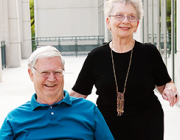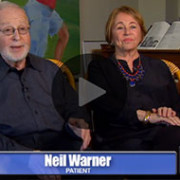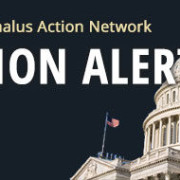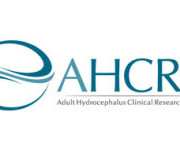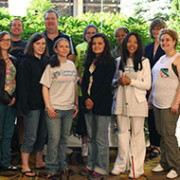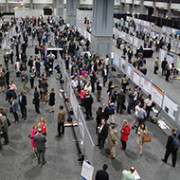Like Father, Like Son: An NPH Journey
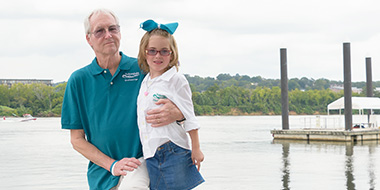
Bob with Ema, a young girl with hydrocephalus
By Bob Neely, Guest Blogger and HA Volunteer
Most people who have heard of hydrocephalus think of the congenital version, afflicting newborns and young children, and are not aware there is a separate, equally devastating version reserved for us old folks and our families named Normal Pressure Hydrocephalus (NPH).
The story below is a very accurate description of NPH. I know, because it is my story. I had a shunt implanted in my head on October 8, 2014, and recovered most of my faculties over 10 months.
My father also was a victim of NPH, which went misdiagnosed for over 8 years.
Instead of sharing his retirement and senior years with his wife (my mother), Genevieve, our family watched him slowly deteriorate from a sharp, friendly, loving southern gentleman to a shuffling recluse who had to wear Depends. His mental and physical condition required constant supervision from Genevieve or a health-care worker.
History would have repeated itself had I not witnessed the slow but ruthless degeneration caused by untreated NPH gone misdiagnosed in my father …
Like Father, Like Son.
My mother and father started a small family business in 1944, in Laurel, Mississippi, when I was three years old. For 40 years they worked hard, long hours together building the company into an industry success and a small business success story. They looked forward to really enjoying their retirement years traveling, golfing, and spending time with their many friends, once I took over the reins. They had earned it.
In 1972, when my dad was 62 years old, I noticed a change in his behavior. He had lost all motivation to continue leading Neely Blue Print. His usual creativeness, enthusiasm, problem-solving skills, and concentration were disappearing. He was unable to remember names, numbers, and sometimes entire conversations. He was easily distracted and would change the subject to something totally unrelated to the current conversation. Something had changed. I did not realize at the time it was his mental state, an indicator of what was to come.
He retired from Neely’s in 1978. His energy level was down, and it took him longer to perform the same tasks he had performed automatically all his career. He had to quit driving his car. He loved to play golf, bridge or poker with his buddies, but had to stop because he couldn’t remember the rules, keep score or track of whose turn it was. He could no longer stand over a golf ball and hit it with any accuracy, nor could he remember where it landed on the fairway … if it landed on the fairway. He was unable to travel, play games, or read (he had always been an avid reader to compensate for his lack of formal education). He had been diagnosed with type 2 diabetes in 1962, and was supposed to exercise by walking every other day, but he could not maintain his balance and had to stop. He kept stubbing his feet on the asphalt bumps and ridges on the street in front of his house.
His physician was also a close family friend and tried to diagnose the problem, but could not find what was causing such a swift decline into senility. Remember, in the 1970’s little was known about neurological problems like “adult onset” hydrocephalus. Even Alzheimer’s and Parkinson’s disease were largely unknown. There was no CT-scan or MRI imaging; no internet or Google search, medical search databases or web-sites for easy sharing of medical or diagnostic information. His physician told him he was just getting old and senile.
Around 1982 his doctor attended a medical convention where one of the speakers made a presentation on “adult onset hydrocephalus.” As soon as he returned to Jackson he reexamined dad’s condition and realized it fit the description he had just heard described at the conference.
A shunt was implanted in my dad’s skull. It resembled the bulb gas-line primer on a power lawn mower or chain saw. My mom had to press it several times a day to flush the Cerebral Spinal fluid (CSF) out of the ventricles in his brain. While it stopped the rapid degeneration, it was too late for any improvement or recovery. He was unable to take care of himself. My mom, who was battling breast cancer, also had to take care of my dad.
My dad passed away March 30, 1994. He was 83 years old when he died. My mom passed away in September that same year. She had fought the breast cancer since 1981 and was determined to take care of her husband and life-long business partner, and never let him be placed in an assisted living facility (nursing home). Once he was gone, she had about 4 months to visit and renew old friendships before she joined him. Now they both enjoy each others company in heaven, eternally.
I made a promise to my family and myself I would never be a willing victim of NPH. My father and I were almost identical in body shape and type, give or take 32 years …! He and I both were diagnosed with type 2 diabetes the same year of our lives. We worked together, ate together, shared the same environment for most of our lives. I had a premonition that I would one day fight NPH. I had a CT scan performed in 2006 in Clearwater, Florida which showed no signs of enlarged ventricles. At the time I did not know the “signs” to look for.
In late 2011, I noticed some deterioration in my balance, and began having problems performing tasks, particularly planning or analysis. I was actively involved in a local volunteer ministry that specializes in building an installing disability ramps for families with beloved members who are wheelchair bound. It took me a lot longer to complete an application, or draft a plan for a disability ramp and prepare a materials purchase order. I also developed a hand/eye coordination problem; typing on a keyboard without wearing out the backspace and delete keys, being unable to remember a measurement long enough to record it on a ramp plan or mark the board for cutting.
During my 2014 six-month physical with my primary care physician (PCP), I mentioned some of my problems and raised the possibility that I might be in the early stages of “adult onset hydrocephalus.” He said maybe I was developing Alzheimer’s or maybe Parkinson’s but not to worry unless it got worse. I mentioned my father suffered from misdiagnosed hydrocephalus and it turned him into a zombie the last 10 years of his life, and I was not going to let it happen to me without a fight …! My PCP did not know what I was talking about!
When I got home following the exam, I started researching the Internet for information of Adult Onset Hydrocephalus. I found articles from teaching hospitals like John Hopkins, the National Institute of Health, neurology and neurosurgeon clinics, and finally the Hydrocephalus Association.
When I returned, for my second semi-annual exam, I came prepared. I had a diary of specific symptoms and a record of continuing deterioration of memory and lack of motivation. When presented with this information and my insistence on checking for swollen ventricles, my PCP reluctantly ordered a CT scan which was performed the next day. Sure enough the ventricles were swollen and I was scheduled to see a neurologist.
I was dismayed to learn the first open appointment date was two months away, which meant my condition would have progressed eight months from the first doctor visit. I got on the cancellation list and was thrilled to see the neurologist the very next day. Things were moving along after all and I felt blessed. Even better, he had just recently graduated and begun practicing in Chattanooga, Tennessee. He was very familiar with NPH, it’s symptoms, diagnosis and treatment. He performed a comprehensive examination testing my mental condition, medical history and observing my gait. Based on the exam, he ordered an MRI which confirmed the CT-scan diagnosis: swollen ventricles. He then ordered a lumbar puncture, or spinal tap, which removes an certain amount of cerebral spinal fluid, reducing the CSF pressure in the brain. Once removed, fluid pressure was reduced and my symptoms immediately disappeared for 3 days! This improvement indicated that NPH was present, and confirmed my candidacy for a shunt implant.
I am happy to report that I had successful shunt implant surgery in October 2014. The surgery lasted 45 minutes and I stayed in the hospital overnight. My symptoms have either disappeared or are slowly decreasing.
I am now a volunteer with the Chattanooga Hydrocephalus Association Community Network and WALK and hope to help create awareness of NPH in our senior population, their health-care providers, and Primary Care physicians. Most of the active volunteers consist of mothers of infants and children born with pediactric hydrocephalus. It is a joy and inspiration to work with them.
I cannot ignore the fact that neither myself nor my PCP would have been aware of why my balance, short-term memory, cognizance, and energy level were going south if it had not been for my journey. My father, “The Boss,” mentored me right up to the end, even though he wasn’t aware of it. His leadership style always was “lead by example.”
God truly blessed me to be his son. If sharing our experience will prevent you and/or your family and friends from the suffering, frustration, lost opportunity, and/or loss of quality of life caused by Normal Pressure Hydrocephalus, it will enhance his legacy. Below are the lessons I learned:
- You are responsible for your own health. You are responsible for learning what your symptoms are, and how best to accurately describe them to your Primary Care Physician. You cannot expect him or her to automatically think “NPH!”
- Learn the “Triad of Symptoms” for NPH. They are very similar to the symptoms of Alzheimer’s or Parkinson’s, but there are subtle differences that will help your medical team members properly diagnose and treat your illness. Visit the NPH area of the Hydrocephalus Association’s website to learn more.
- NPH is sneaky. The changes can be so slow you don’t realize they’re happening (i.e. the frog on the stove analogy). It disguises itself as “just old age” or one of the better known senior diseases like Alzheimer’s or Parkinson’s.
- The kink in the hose blocking a patient’s access to neurologists and neurosurgeons seems to be your Primary Care Physician. For many of us, you cannot go directly to a neurologist … you have to be “referred”. If your referrer does not know what NPH is, you are stymied. Statistical studies estimate 80% of the 700,000 older (60 yrs) Americans with NPH are not aware of it.
- NPH is controllable, particularly if diagnosed early. Alzheimer’s and Parkinson’s is not. Treatments for Alzheimer’s or Parkinson’s will not help NPH!
- Stay Healthy! Don’t mask, accelerate, or exacerbate health problems with untreated diabetes, smoking, excess alcohol consumption, poor health habits, and not exercising.
- Information and Support is Available. Thanks to modern medical science diagnostics and technology, the growing amount of information available over the Internet, and support groups like the Hydrocephalus Association, which has Community Networks around the country and a national headquarters in Bethesda, Maryland, can provide the Baby Boomer Generation with good information. Baby Boomers are reaching the age when NPH usually occurs (60 years).


